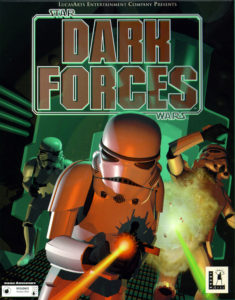
Welcome to the HoloNet Uplink, citizen. This series focuses on Fantasy Flight Games’ Star Wars Roleplaying Game, with content aimed mostly at the Gamemaster. Threats, adventure seeds, rules supplements, and more are all to come for those who access The HoloNet Uplink.
 With Games of Yore Week upon us I finally have an excuse to talk about one of my favorite PC games of all time: Dark Forces. Before Rogue One threatened to explain the Death Star Plans once and for all, there was the epic adventure of Kyle Katarn – ex stormtrooper officer, mercenary for the Rebellion, and one man army in the finest of first person shooter traditions. The nostalgia is strong with this one, despite my not having played the original in 1995. My excuse? I was 5 years old then. But give a young guy some slack, please, as Kyle Katarn doesn’t even have a beard yet in this title. I may not have played this title right at launch, but I have more than made up for that deficiency by countless play throughs over the years.
With Games of Yore Week upon us I finally have an excuse to talk about one of my favorite PC games of all time: Dark Forces. Before Rogue One threatened to explain the Death Star Plans once and for all, there was the epic adventure of Kyle Katarn – ex stormtrooper officer, mercenary for the Rebellion, and one man army in the finest of first person shooter traditions. The nostalgia is strong with this one, despite my not having played the original in 1995. My excuse? I was 5 years old then. But give a young guy some slack, please, as Kyle Katarn doesn’t even have a beard yet in this title. I may not have played this title right at launch, but I have more than made up for that deficiency by countless play throughs over the years.
Today’s article is not a review. For a review of sorts that matches my personal opinions of the game quite closely, check out this link. Instead, today I will be putting my own HoloNet Uplink spin on the nostalgia factor for Dark Forces. I’ll go through some of the best, and worst, attributes of the game to provide some “Dos and Don’ts” for Star Wars Roleplaying Game GMs.
Dark Forces Dos
Memorable Locales
Before I sat down to write this article I did a little exercise. I took out a piece of paper and starting to write down the levels I remembered as being cool or memorable. The list didn’t end up being useful in the way I thought it would; there were more levels on the list than off of it! To name but a few there is the classic heist of the Death Star Plans from Danuta, the rugged and dangerous Gromas Mines, and the oppressive weight of Imperial City on Coruscant. Dark Forces was able to establish memorable locales despite having only a limited number of textures and enemies. This was accomplished through music, level design, and excellent use of limited visual resources.
Apply this in your game using detailed, sensory descriptions. Use music and ambient sound to help set the scene. YouTube has excellent ambient tracks uploaded from your favorite Sci Fi series, and of course there is the aptly named Tabletop Audio.
Unique Challenges
To go along with its memorable locales, Dark Forces is not simply a stormtrooper blasting simulator. From your initial fights with each phase of the Dark Trooper project to the duel with Boba Fett, and even “mixed reviews” elements like the dreaded puzzles and the awesome “Kyle punches out a Kell Dragon” section, Dark Forces spices things up by putting in those unique adversaries and encounters. Special jumping and movement challenges add to the variety, such as the hilariously dangerous Gromas Mines or the treacherous ice of Anteevy, requiring a combination of items and player skill to surmount.
Be creative. Whip out The List but be prepared to break some of the rules, bust out those cool threats like rancors and sarlaccs (oh my!), and try out the funkier rules like high and low gravity. Don’t fall into the trap of relying on “balanced” encounters in spaces which provide even opportunities, every once and a while put something truly unique out there.
Immersion, Atmosphere, and Details
Anoat Sewers are terrifying. I don’t care if its not even real 3D. In low light and darkness, with murky water filling the sewers, and dianogas striking out of the depths this level gives me the creeps so badly that on some saves I just use the level skip cheat. That a game with such primitive graphics can have this effect on a quasi-grown up pseudo-adult such as myself is of note. On the flip side, nothing quite puts a smile on my face like blasting Imperials in the Secret Base on Danuta, or the Executor, with the John Williams score blaring in MIDI glory. Other levels benefit from clever touches, like Imperial Officers discussing important matters in a conference room or catching stormtroopers in the men’s room.
Atmosphere and tone can be tricky to convey. Enter the Unknown has a good starting point in its section on horror. To enhance immersion take a page from the stormtrooper men’s room. I like to think of my campaigns as being set in a world that is a real place, in which NPCs have business and pleasure to go about. There needs to be the occasional sign of this, with details adding to the realism without necessarily being connected to the story. This will help you create the “used future” feel so important to this setting.
Dark Forces Don’ts
Frustrating Puzzles
Memorable locales and unique challenges are great. But anyone who has played this game can attest to its frustration factor when you just aren’t getting the puzzles. Despite my strong nostalgia for Imperial City on Coruscant when it comes to the door puzzle in Imperial Security Operations I just can’t help but turn to an online guide. Jumping in the platform style works pretty well in this game, retaining the feel of a high energy adventure, but it is just plain disappointing when this game grinds to a halt because I can’t remember the solution to a puzzle and just don’t get it for whatever reason..
You may have experienced this sort of meta-game puzzle solving in tabletop roleplaying before. I’ve been on the receiving end several times in Dungeons and Dragons. I’ve never been a fan. Aside from a hilariously broken puzzle getting a good laugh from the gaming group one time, I have never had a good experience with these metagame puzzles. My recommendation: this is a Dark Forces Don’t, so give it a skip in your games.
Getting Lost
Dark Forces certainly is a clear example of older school level design. Levels have many nooks, crannies, twists, and turns. As discussed, there is a nice sense of realism. This is very appreciated until I need to backtrack across the level to get the Blue Key I forgot on the second floor, in order to get a combination code for the first floor, only to head back to the start point. All good until I take a wrong turn. Ten minutes later after guessing and checking my route on the map my adventure continues, but again grinding the fun to a halt.
Fantasy Flight Games’ edition of the Star Wars Roleplaying Game and its range bands certainly discourage precision-detailed map grid play, and even in previous editions the kind of dungeon delving where the players draw out their own map while listening keenly to the GM’s descriptions was very rare, but there is a risk nonetheless. It can be fun to plan out Imperial battle stations and the like, but avoid getting nitty gritty into mapping them out with all the twists and turns, the rights and lefts. Paying too close attention to these details will bog down your game, eating up valuable time better spent on exciting encounters.
Gamers, if you haven’t played Dark Forces I think you are sorely missing out. There are few titles I turn to as often for inspiration or even just plain recreation as this classic. I’d love to hear what you think of this game in the comments below, and your opinions on what tabletop lessons we can learn from video games in general. See you in the comments.
Extra note: Folks looking to play Dark Forces today can check this game out on Steam or Good Old Games.
